 | |
           2026 Sistema Cheve |
1984 Peña Colorada Expedition Photos
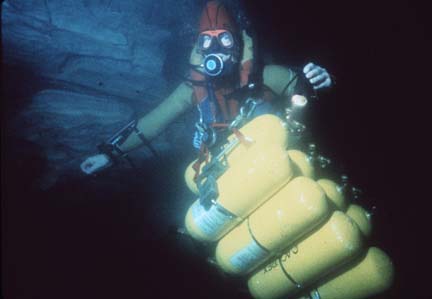 The problems with open circuit scuba: Rob Parker transporting a "sled" of 8 composite tanks 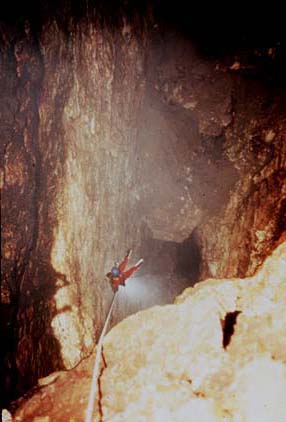 Sump 7: The Ultimate Speleological Obstacle. Noel Sloan is shown here descending the 55 meter (180 foot) freefall drop leading directly into Sump 7, the most remote underwater tunnel discovered in the Cueva de la Peña Colorada. Despite significant attempts to locate a bypass, exploration efforts began here in April of 1984 with Bill Stone (supported by Bob Jefferys) making a solo exploration of the sump. Stone reached a depth of 43 meters (140 feet) where he turned around on air limits at the beginning of a large horizontal gallery, headed north towards Sistema Huautla. Two weeks later, John Zumrick and Clark Pitcairn extended the line to a distance of 165 meters from dive base at 55 meters water depth. The tunnel still continues as an 8x13 meter canyon. A 7°C temperature drop from the surface of Sump 7 to the main horizontal gallery suggests that the active "Main Drain" flow of Sistema Huautla was reached during this effort. 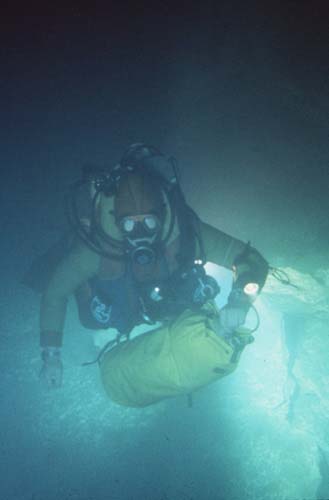 Rob Parker transporting gear through Sump 5 (140 meters long). Inside the duffel were food supplies, carbide, and climbing gear needed at Camp 2. Sleeping bags, hammocks, and cook gear had already been transported through by Bob Jefferys, Clark Pitcairn, Noel Sloan, and John Zumrick. 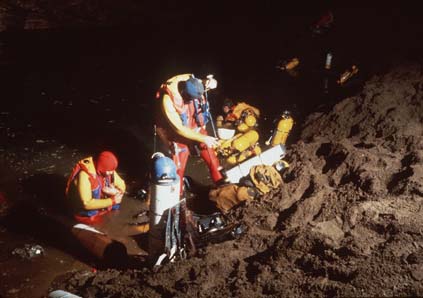 Pat Wiedeman (left), Bob Jefferys, and John Zumrick kit up at Sump 3. This was the first extensive use of composite tanks for cave diving (the dive at the San Agustin Sump in April 1981 was the only previous effort to use this technology). The team used 72 of the composite vessels (manufactured by Acurex [now EFIC]) to traverse six sumps and 4.2 kilometers of dry cave galleries separating the sumps. Sump 3 was 190 meters in length and reached a maximum depth of 22 meters. 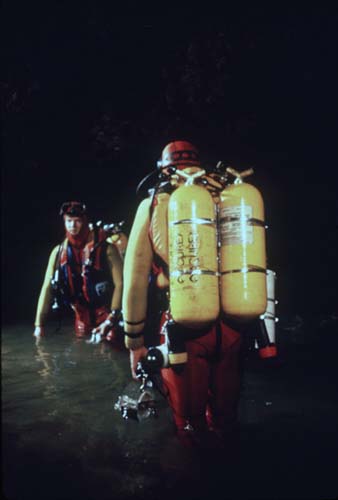 Clark Pitcairn (left) and Gary Storrick prepare for the original exploration dive in Sump 2 in late February 1984. The tanks are the novel fully overwrapped composite design first used during the 1981 Agua de Cerro Expedition. Weighing only 23 pounds full (105 cubic feet of breathing gas) they provided a huge advantage for transport over rugged air-filled terrain - which comprised 80% of the passages in the Peña Colorada. The valving system provided for dual regulators and the ability to isolate either tank from the system during the course of a dive. This design, developed by John Zumrick and Bill Stone, was the precursor to many of the modern dual valve manifolds used today. 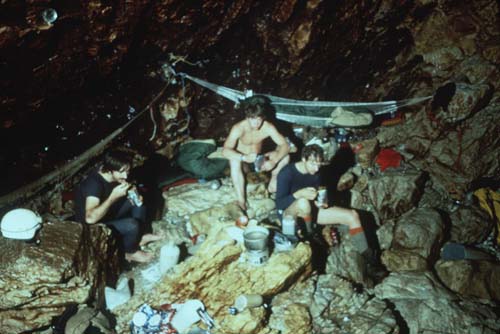 Spartan Outpost: Left to Right: Bob Jefferys, Rob Parker, and Noel Sloan work on a humble meal of freeze dried food at Camp 2, 4.2 kilometers from the entrance and beyond six sumps comprising a kilometer of underwater travel. Camp 2 was occupied for 7 days during the 1984 expedition. Only the clothes worn under each person's wetsuits were taken beyond Camp 1. Just 20 meters beyond this camp lies "Sherwood Shaft," the 55-meter pit leading down to Sump 7. 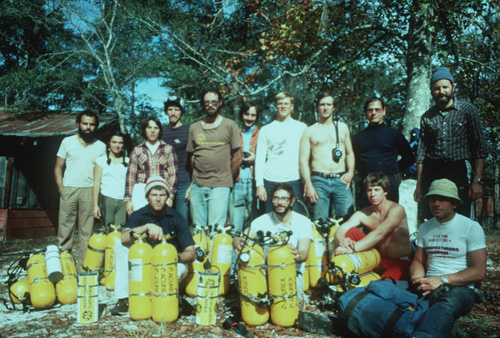 Team photo during training in the fall of 1983 at Indian Springs, Florida. Rear, left to right: Carlos Lazcano, Elena Lazcano, Pat Wiedeman, Bill Stone, Gary Storrick, Bob Jefferys, Clark Pitcairn, Noel Sloan, John Zumrick, Sergio Zambrano. Front, left to right: Clark Daily, John Evans, Rob Parker, Angel Soto. |
| Copyright © 2025 U.S. Deep
Caving Team, Inc. All rights reserved. Todo el contenido tiene derechos de autor del U.S. Deep Caving Team. Todos los derechos reservados. No portion of these pages may be used for any reason without prior written authorization. | |

